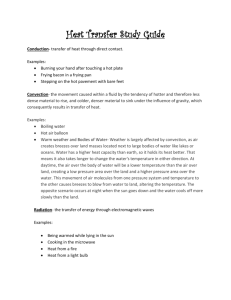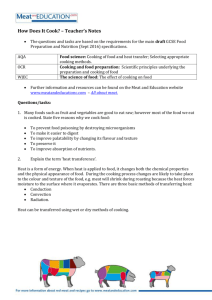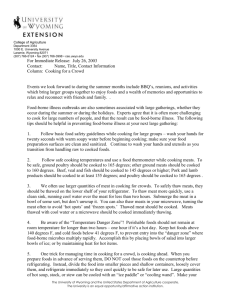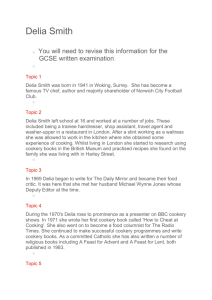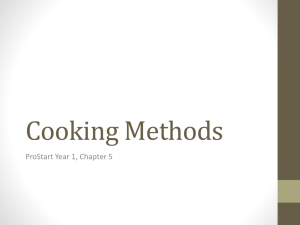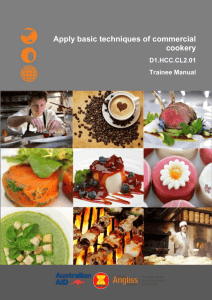Chapter 10 Methods Questions
advertisement
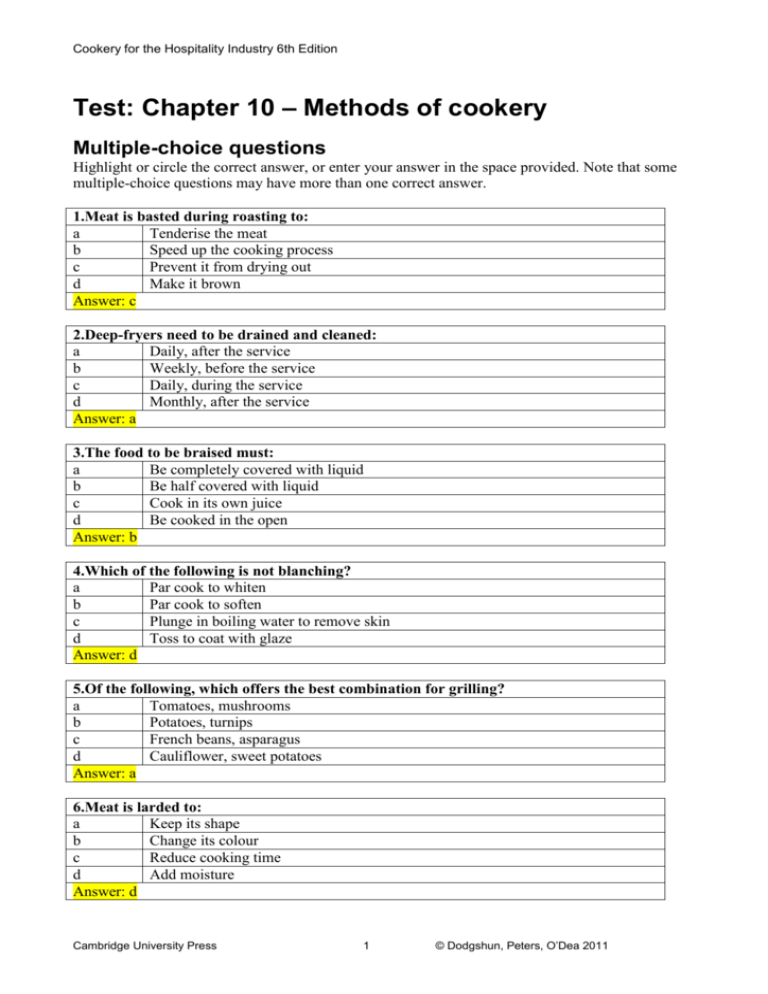
Cookery for the Hospitality Industry 6th Edition Test: Chapter 10 – Methods of cookery Multiple-choice questions Highlight or circle the correct answer, or enter your answer in the space provided. Note that some multiple-choice questions may have more than one correct answer. 1.Meat is basted during roasting to: a Tenderise the meat b Speed up the cooking process c Prevent it from drying out d Make it brown Answer: c 2.Deep-fryers need to be drained and cleaned: a Daily, after the service b Weekly, before the service c Daily, during the service d Monthly, after the service Answer: a 3.The food to be braised must: a Be completely covered with liquid b Be half covered with liquid c Cook in its own juice d Be cooked in the open Answer: b 4.Which of the following is not blanching? a Par cook to whiten b Par cook to soften c Plunge in boiling water to remove skin d Toss to coat with glaze Answer: d 5.Of the following, which offers the best combination for grilling? a Tomatoes, mushrooms b Potatoes, turnips c French beans, asparagus d Cauliflower, sweet potatoes Answer: a 6.Meat is larded to: a Keep its shape b Change its colour c Reduce cooking time d Add moisture Answer: d Cambridge University Press 1 © Dodgshun, Peters, O’Dea 2011 Cookery for the Hospitality Industry 6th Edition 7.The correct amount of liquid added to a stew is: a To ¼ cover the item b To ½ cover the item c To ¾ cover the item d To just cover the item Answer: d 8.Simmering takes place at a temperature of: a 80º–88º Celsius b 85º–90º Celsius c 95º–98º Celsius d 100º–110º Celsius Answer: c 9.Docking is a term best related to which method of cookery? a Roasting b Microwave c Baking d Poêlé Answer: c 10.The correct culinary term for the group of butters often served with grilled food is: a Beurre Manié b Panadas c Quenelles d Compound butters Answer: d 11.Jus roti is also known as: a Lamb stew b Beef stock c Meat glaze d Roasting juices Answer: d 12.Grilling uses which source of heat transfer: a Conduction b Radiation c Convection d Electro-magnetic radiation Answer: b 13.A court-bouillon would be best suited to which method of cookery: a Boiling b Sauté c Poaching d Sous vide Answer: c Cambridge University Press 2 © Dodgshun, Peters, O’Dea 2011 Cookery for the Hospitality Industry 6th Edition 14.The approximate ratio of water to pasta when boiling is: a 1:2 b 1:5 c 5:1 d 10:1 Answer: d 15.When using the cookery method of poêlé, the basting agent of choice is: a Olive oil b Lard c Butter d Ghee Answer: c True or false questions Highlight or circle the correct answer, or enter your answer in the space provided. Answer true or false about methods of cookery. 1. Roasts should be rested before carving. True False 2. When baking food, it is not necessary to preTrue False heat the oven. 3. ‘Bain-marie’ means boiling in water. True False 4. Food should be drained well before deep True False frying. 5. Stewed fruits should be cooked rapidly. True False 6. Braised meat is usually cooked in a large True False piece. 7. Stir-fry is only used for vegetable cooking. True False 8. Pilaf rice is cooked by braising. True False 9. When shallow frying the presentation side of True False food is cooked first. 10. Stewing is suited to second class cuts of True False meat. 11. Sous vide is a quick method of cooking. True False 12.Meringues are baked at temperatures < 100° True False Celsius. 13. Crème brûlée and crème caramel are baked True False at approximately 250° Celsius. 14. Pastry, breads are baked at temperatures True False between 180° and 220° Celsius 15. Compound butters are associated with the True False grilling cooking method. Answers: True, False, False, True, False, True, False, True, True, True, False, True, False, True, True Cambridge University Press 3 © Dodgshun, Peters, O’Dea 2011 Cookery for the Hospitality Industry 6th Edition Short-answer questions Enter your answer in the space provided. 1. List two reasons we cook food. To make it more digestible. To make it safer to eat. To make it more palatable. To change its appearance. Other suitable answer. 2. Identify three methods of heat transfer and give a definition for each. Conduction – heat transfer through direct contact Convection – heat transfer through fluids Radiation – no direct contact of heat source and item being cooked – heat travels in waves Electromagnetic radiation – heat generated in food through the action of a magnetron in a microwave oven 3. Define the following terms as applied to boiling. Blanching subjecting food to the action of boiling water for a short period of time. It is performed for one or more of the following reasons: to par cook, remove skins, whiten, retain or improve colour, or partially remove excess flavour. Refreshing the process of arresting the cooking of items that have been boiled or blanched by immersing the food items into cold or iced water until they are cooled. This prevents further cooking. Simmering the careful, gentle boiling of food. It occurs between 95° and 98° Celsius and is indicated by the gentle movement of liquid and small bubbles. 4. Identify and define two different types of poaching. Poaching – food is subjected to heat in a liquid. The liquid may include water, stock, sugar syrup, milk, wine, court-bouillon etc., but not oil or fat. Poaching is indicated by very gentle movement of liquid with small bubbles. Deep poaching items are totally submerged in a liquid, usually seen with large whole fish, whole poultry or whole fruit. The liquid used to start the poaching may be hot or cold, depending on the food type. Shallow poaching items are placed in sufficient liquid to just cover the item. The liquid can be used to produce accompanying sauce. 5. Suggest two reasons a court-bouillon may be used when poaching. To enhance the flavour of food items cooked in it; to help stabilise the protein in soft-textured foods such as brains, fish and eggs and therefore help to retain shape; and to change the colour of certain items such as trout. Other suitable answer. 6. Identify two applications of sous vide cookery in the food service industry. In the bulk production of food such as that associated with cook–chill. In restaurants to produce dishes of extraordinary tenderness and texture utilising second-class cuts of meat, poultry, game etc. Cooking dishes utilising the sous vide method can add variety and interest to your menu ____________________________________________ ____________________________________________ Cambridge University Press 4 © Dodgshun, Peters, O’Dea 2011 Cookery for the Hospitality Industry 6th Edition 7. Identify two advantages and two disadvantages of steaming as a cookery method. Advantages of steaming include: retention of nutrients and food colour through reduced cooking times. Disadvantages of steaming include: difficulty in retaining natural cooking juices and modifying the flavour with added ingredients. In some cases there can be an overall loss in flavour or blandness associated with steamed food. Other suitable answer. ____________________________________________ 8. Identify food items that are suited to stewing as a method of cookery. Second-class cuts of meat, poultry and game etc. whose connective tissue needs long, slow cooking to help tenderise. Stewing is also suited to fibrous fruits and vegetables or hard vegetables such as those from the root classification whose structure can hold up to long cooking and therefore retain its shape. 9. What is the difference between braising and stewing? The amount of liquid used – braising items should be ⅓ – ½ covered; stewing items should be just covered with a liquid. Meat to be stewed is generally smaller in size or diced, whereas whole joints of meat can be braised and cut, portioned or carved prior to serving. 10. Identify three suitable thickening agents for a stew or braise. Used at the start – flour, roux, weight of ingredient Used at the end – Beurre Manié, arrowroot, cornflour, fecule, rice flour Other suitable answer. 11. Define the term ‘barding’. Barding is a form of ‘external moisturising’, whereby food items are wrapped in some form of fat. It is done to prevent excessive drying out of items being cooked and is especially associated with small game/poultry items, such as quail wrapped in prosciutto. 12. In which cookery method are you likely to encounter a mirepoix bordelaise? Poêlé or pot roasting 13. What is the difference between baking and roasting? During roasting, oil or fat is used and the item is continually basted during the cooking process. 14. Explain what is meant by the term cooking ‘au bain-marie’. This refers to cooking in a water bath. Containers of food are placed into a dish or tray, which is then at least ¾ filled with near-boiling water. The dish is then placed into the oven to cook. It is important that near-boiling water is used so the oven does not have to heat cool water first before the cooking is effected. A bain-marie helps to provide a gentler and more regulated heat, and they are used almost exclusively for dishes that include eggs such as: brûlée, bread and butter puddings, baked custards, pâtés etc. Cambridge University Press 5 © Dodgshun, Peters, O’Dea 2011 Cookery for the Hospitality Industry 6th Edition 15. Identify three points of care when shallow-frying food. The fat used should be sufficiently hot to quickly seal and colour as well as to prevent the item from absorbing the fat. Food should be cooked presentation side first as this side will obtain a better and more even colour. The size of the pan used should be in keeping with the amount of food that is being cooked. Unused fat can quickly overheat and burn. When cooking crumbed food, the frying medium should be changed regularly, ideally after each item has been cooked, to prevent loose breadcrumbs from burning and spoiling any subsequent cooking. Care should be taken to ensure that the frying medium temperature does not become too hot, causing the item to burn on the outside before the inside is cooked. Other suitable answer. 16. Explain the main differences between shallow frying and sautée as methods of cookery. The term sauté comes from the French verb meaning to ‘jump’ and indicates that the food being cooked is ‘tossed’ during the cooking process. This is something that is obviously not possible for larger cuts of food or for items being fried in a larger amount of oil or fat – both of which apply to shallow frying. The other main difference between the two methods is that food which is sautéed makes use of the sediment and natural juices that remain in the pan to make an accompanying sauce. Shallow-fried foods generally do not make use of sediment or juices due to the amount of oil or fat they are cooked in. Crumbed items that are shallow fried have a tendency to lose some of their coating when being cooked, further complicating the production of a sauce. 17. Identify three points of care related to the cookery method stir frying. All ingredients must be cleaned, dried and assembled before starting to cook. Ingredients must be cut to a similar size and shape, as cooked pieces must look uniform and have the same tenderness. Most chicken, fish, pork and beef are marinated beforehand, to enhance taste and tenderness. Items are often coated with cornflour prior to cooking. Some oil should be heated in the wok, swirled around and the excess removed prior to cooking. A little oil should be added to meat and fish just prior to cooking. This will aid separation in the wok. Stir frying is a very quick process. Items requiring long cooking must be precooked to tenderness by other methods. Other suitable answer. Cambridge University Press 6 © Dodgshun, Peters, O’Dea 2011 Cookery for the Hospitality Industry 6th Edition 18. Identify four safety considerations when operating a deep fryer. Always follow the manufacturer’s instructions. Never fill the deep fryer with oil or fat above the line indicated. Change and filter the frying medium as required. Never run in the kitchen, especially near a deep fryer. Never bring water to the deep fryer – drain food to be cooked elsewhere and pat the food dry hygienically where possible. Never overload a deep fryer – as well as lowering the temperature it can lead to the frying medium overflowing. Keep your sleeves rolled down when operating a deep fryer. Use baskets and spiders to lower the food where possible. Stand back to avoid steam burns or being splashed with hot frying medium. Periodically check the thermostat to ensure it is working accurately and not overheating the frying medium. Do not allow the frying medium to exceed a temperature of 204° Celsius. Be familiar with the location and correct use of fire blankets and fire extinguishers. ________________________________________________ 19. Identify four suitable coatings for food that is being deep fried. Flour Usually done more for colour than protection; e.g. a chicken breast fillet prior to shallow frying or some vegetables before deep frying. Pané Anglaise Items are passed through seasoned flour, egg wash and finally fresh breadcrumbs. Used for both shallow and deep frying. À la Française Items are passed through milk and then flour. Used for deep frying, especially with onions and eggplant. Batters Can include beer, yeast, plain and tempura. Items are seasoned, floured and then passed through the batter. Used for deep frying. Pane Milanaise Same as Anglaise except the breadcrumbs contain one part parmesan cheese for every two parts breadcrumbs. Used for both shallow and deep frying. 20. Identify three advantages in using a microwave oven in a commercial kitchen. Food can be heated in small quantities very quickly. It is particularly suitable for heating pre-plated or ready-to-eat food. If it is used correctly, there is no loss of flavour. Hot food can be boosted to correct serving temperatures. Food can be kept cold, and single portions can be heated to order, thus keeping the food fresher. Waste can be avoided by heating food only when required. By combining a microwave oven with conventional cooking appliances, cooking times can be shortened. Microwave ovens are very compact and do not require extraction canopies. Other suitable answer. Cambridge University Press 7 © Dodgshun, Peters, O’Dea 2011

